Disadvantages of Paper Medical Records and Benefits of EHR
VerifiedAdded on 2023/01/17
|9
|2310
|99
AI Summary
This article discusses the disadvantages of keeping paper medical records and the need for quality improvement in this area. It also explores the benefits of implementing Electronic Health Records (EHR) and Electronic Medical Records (EMR) in healthcare organizations. The article highlights the impact on evidence-based practice and the advantages of EHR over paper-based records. It also discusses the implementation process of EHR and EMR in hospital organizations.
Contribute Materials
Your contribution can guide someone’s learning journey. Share your
documents today.
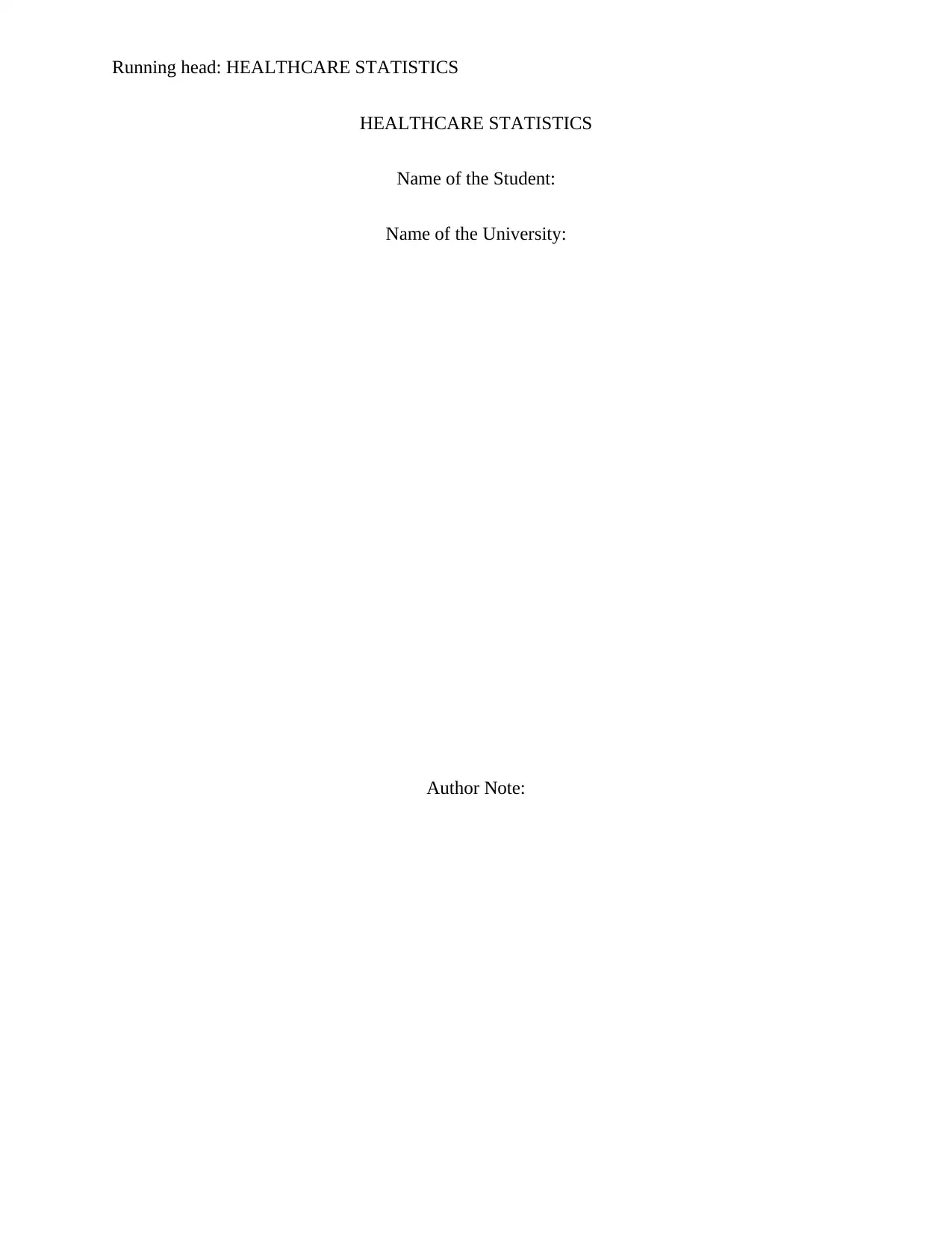
Running head: HEALTHCARE STATISTICS
HEALTHCARE STATISTICS
Name of the Student:
Name of the University:
Author Note:
HEALTHCARE STATISTICS
Name of the Student:
Name of the University:
Author Note:
Secure Best Marks with AI Grader
Need help grading? Try our AI Grader for instant feedback on your assignments.
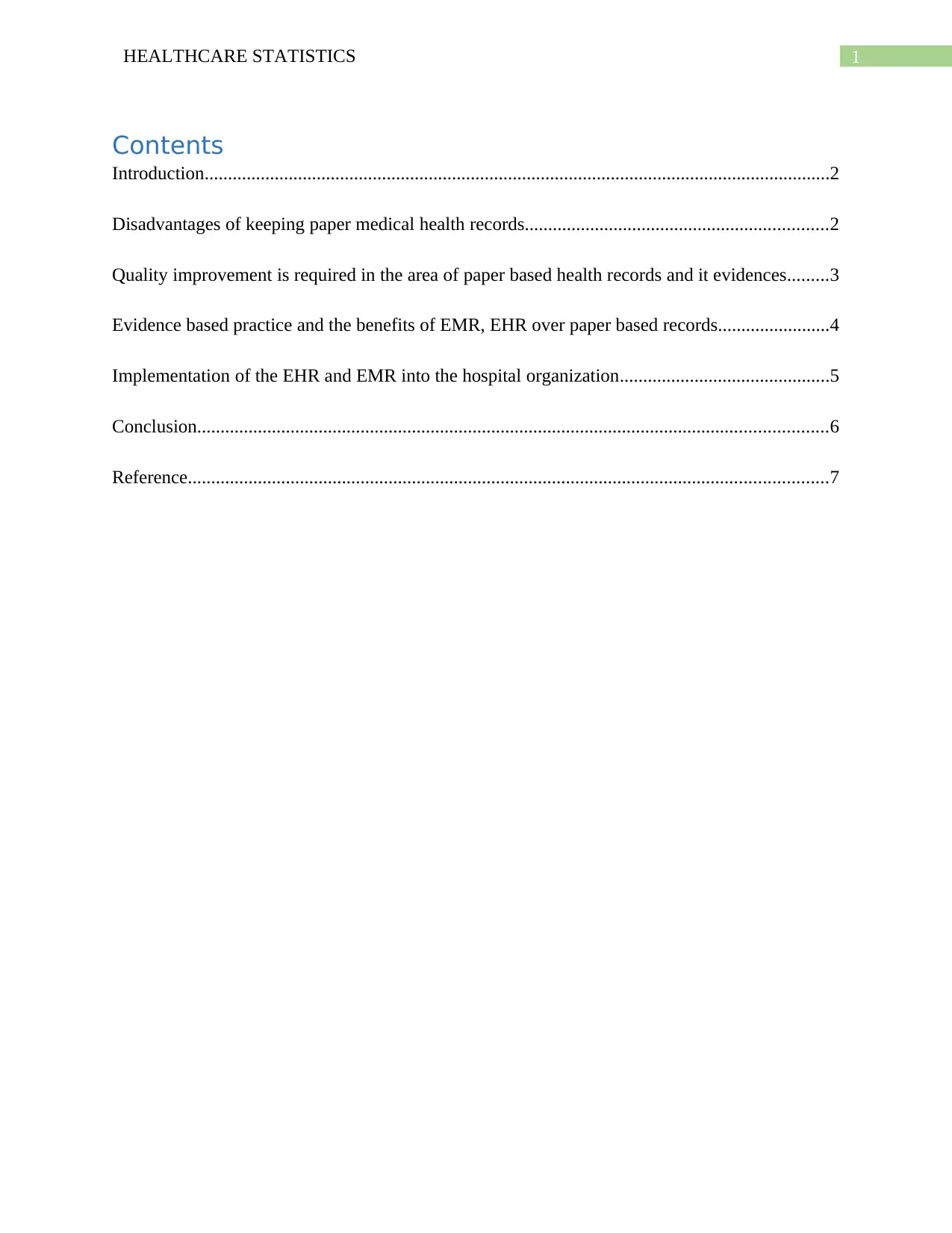
1HEALTHCARE STATISTICS
Contents
Introduction......................................................................................................................................2
Disadvantages of keeping paper medical health records.................................................................2
Quality improvement is required in the area of paper based health records and it evidences.........3
Evidence based practice and the benefits of EMR, EHR over paper based records........................4
Implementation of the EHR and EMR into the hospital organization.............................................5
Conclusion.......................................................................................................................................6
Reference.........................................................................................................................................7
Contents
Introduction......................................................................................................................................2
Disadvantages of keeping paper medical health records.................................................................2
Quality improvement is required in the area of paper based health records and it evidences.........3
Evidence based practice and the benefits of EMR, EHR over paper based records........................4
Implementation of the EHR and EMR into the hospital organization.............................................5
Conclusion.......................................................................................................................................6
Reference.........................................................................................................................................7
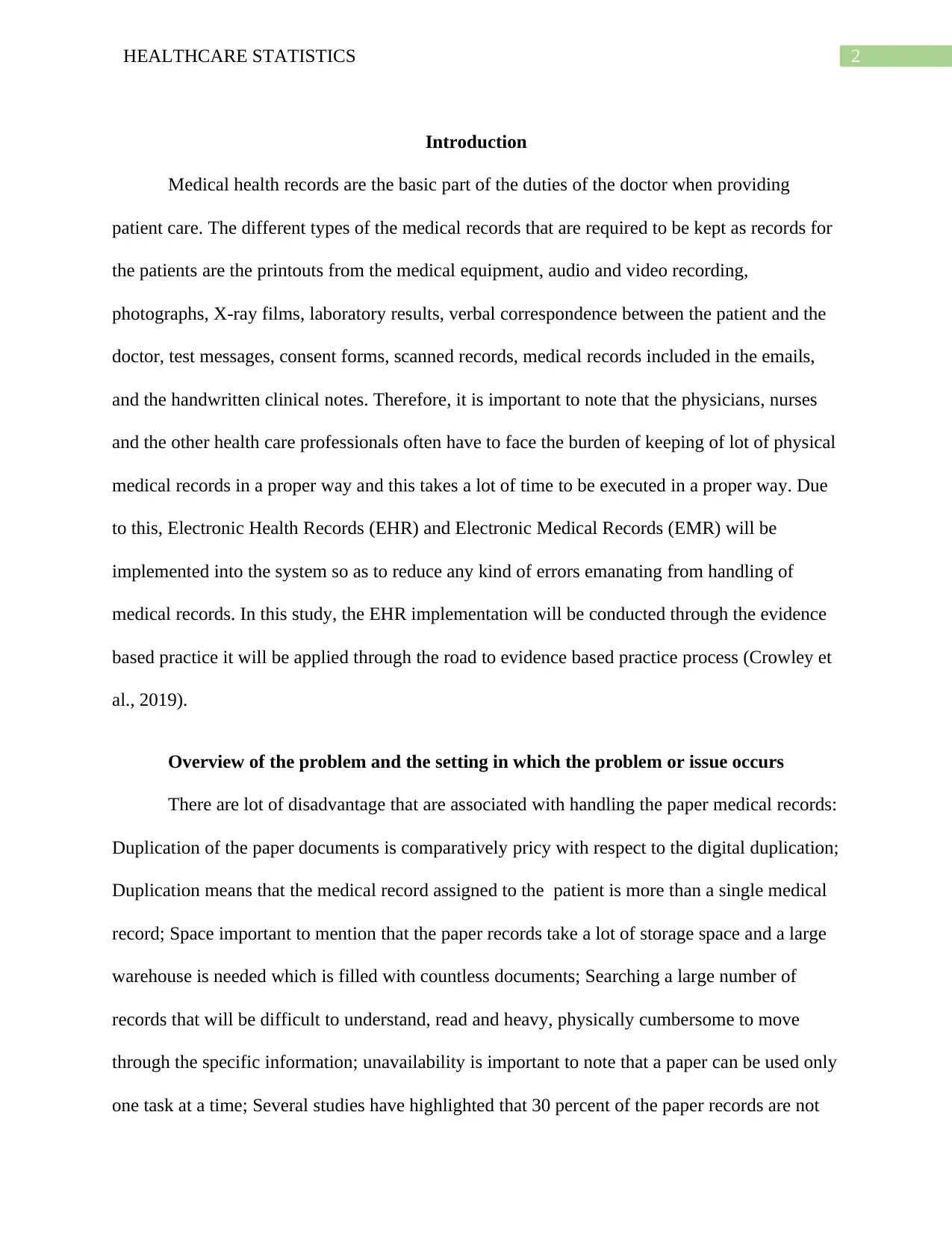
2HEALTHCARE STATISTICS
Introduction
Medical health records are the basic part of the duties of the doctor when providing
patient care. The different types of the medical records that are required to be kept as records for
the patients are the printouts from the medical equipment, audio and video recording,
photographs, X-ray films, laboratory results, verbal correspondence between the patient and the
doctor, test messages, consent forms, scanned records, medical records included in the emails,
and the handwritten clinical notes. Therefore, it is important to note that the physicians, nurses
and the other health care professionals often have to face the burden of keeping of lot of physical
medical records in a proper way and this takes a lot of time to be executed in a proper way. Due
to this, Electronic Health Records (EHR) and Electronic Medical Records (EMR) will be
implemented into the system so as to reduce any kind of errors emanating from handling of
medical records. In this study, the EHR implementation will be conducted through the evidence
based practice it will be applied through the road to evidence based practice process (Crowley et
al., 2019).
Overview of the problem and the setting in which the problem or issue occurs
There are lot of disadvantage that are associated with handling the paper medical records:
Duplication of the paper documents is comparatively pricy with respect to the digital duplication;
Duplication means that the medical record assigned to the patient is more than a single medical
record; Space important to mention that the paper records take a lot of storage space and a large
warehouse is needed which is filled with countless documents; Searching a large number of
records that will be difficult to understand, read and heavy, physically cumbersome to move
through the specific information; unavailability is important to note that a paper can be used only
one task at a time; Several studies have highlighted that 30 percent of the paper records are not
Introduction
Medical health records are the basic part of the duties of the doctor when providing
patient care. The different types of the medical records that are required to be kept as records for
the patients are the printouts from the medical equipment, audio and video recording,
photographs, X-ray films, laboratory results, verbal correspondence between the patient and the
doctor, test messages, consent forms, scanned records, medical records included in the emails,
and the handwritten clinical notes. Therefore, it is important to note that the physicians, nurses
and the other health care professionals often have to face the burden of keeping of lot of physical
medical records in a proper way and this takes a lot of time to be executed in a proper way. Due
to this, Electronic Health Records (EHR) and Electronic Medical Records (EMR) will be
implemented into the system so as to reduce any kind of errors emanating from handling of
medical records. In this study, the EHR implementation will be conducted through the evidence
based practice it will be applied through the road to evidence based practice process (Crowley et
al., 2019).
Overview of the problem and the setting in which the problem or issue occurs
There are lot of disadvantage that are associated with handling the paper medical records:
Duplication of the paper documents is comparatively pricy with respect to the digital duplication;
Duplication means that the medical record assigned to the patient is more than a single medical
record; Space important to mention that the paper records take a lot of storage space and a large
warehouse is needed which is filled with countless documents; Searching a large number of
records that will be difficult to understand, read and heavy, physically cumbersome to move
through the specific information; unavailability is important to note that a paper can be used only
one task at a time; Several studies have highlighted that 30 percent of the paper records are not
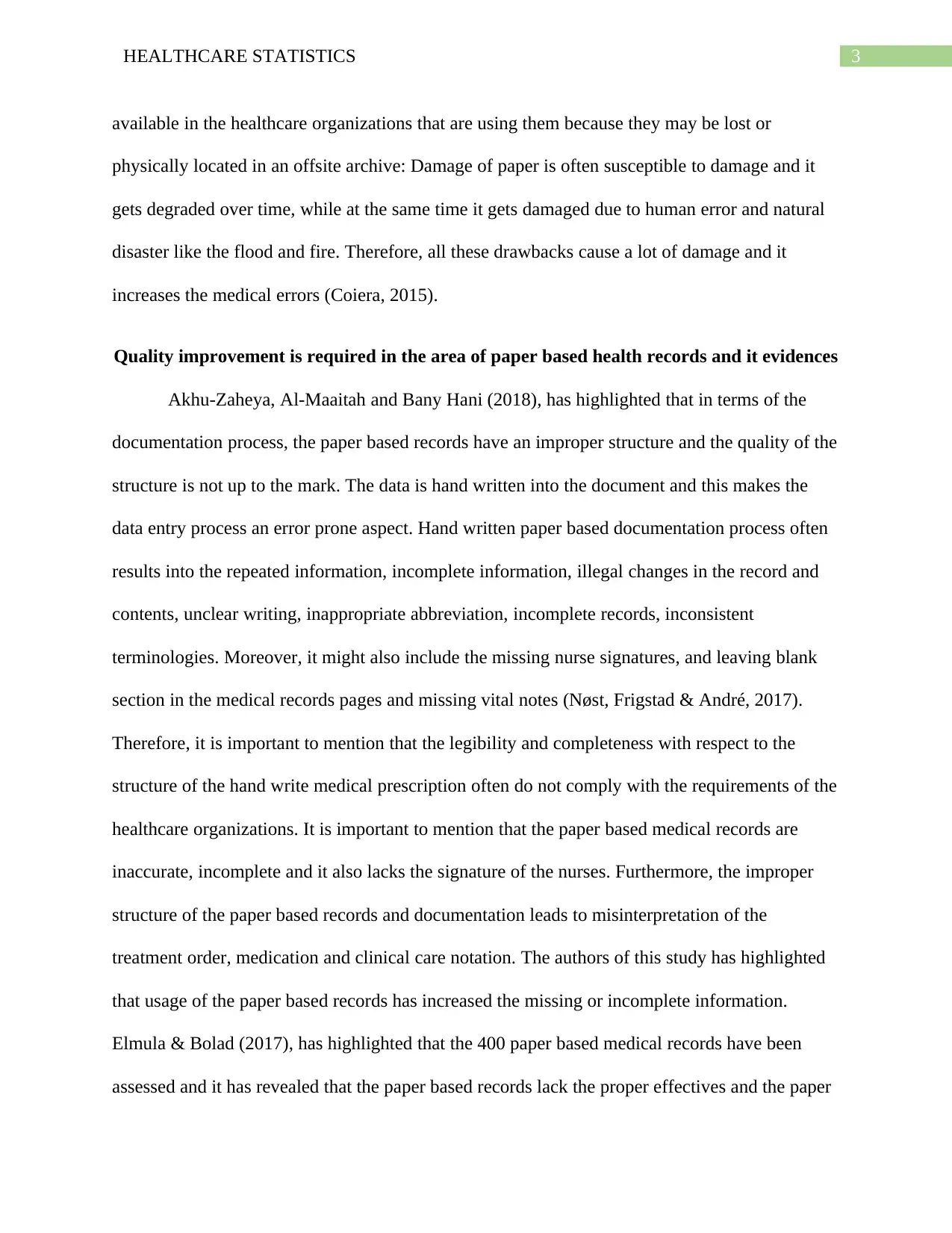
3HEALTHCARE STATISTICS
available in the healthcare organizations that are using them because they may be lost or
physically located in an offsite archive: Damage of paper is often susceptible to damage and it
gets degraded over time, while at the same time it gets damaged due to human error and natural
disaster like the flood and fire. Therefore, all these drawbacks cause a lot of damage and it
increases the medical errors (Coiera, 2015).
Quality improvement is required in the area of paper based health records and it evidences
Akhu‐Zaheya, Al‐Maaitah and Bany Hani (2018), has highlighted that in terms of the
documentation process, the paper based records have an improper structure and the quality of the
structure is not up to the mark. The data is hand written into the document and this makes the
data entry process an error prone aspect. Hand written paper based documentation process often
results into the repeated information, incomplete information, illegal changes in the record and
contents, unclear writing, inappropriate abbreviation, incomplete records, inconsistent
terminologies. Moreover, it might also include the missing nurse signatures, and leaving blank
section in the medical records pages and missing vital notes (Nøst, Frigstad & André, 2017).
Therefore, it is important to mention that the legibility and completeness with respect to the
structure of the hand write medical prescription often do not comply with the requirements of the
healthcare organizations. It is important to mention that the paper based medical records are
inaccurate, incomplete and it also lacks the signature of the nurses. Furthermore, the improper
structure of the paper based records and documentation leads to misinterpretation of the
treatment order, medication and clinical care notation. The authors of this study has highlighted
that usage of the paper based records has increased the missing or incomplete information.
Elmula & Bolad (2017), has highlighted that the 400 paper based medical records have been
assessed and it has revealed that the paper based records lack the proper effectives and the paper
available in the healthcare organizations that are using them because they may be lost or
physically located in an offsite archive: Damage of paper is often susceptible to damage and it
gets degraded over time, while at the same time it gets damaged due to human error and natural
disaster like the flood and fire. Therefore, all these drawbacks cause a lot of damage and it
increases the medical errors (Coiera, 2015).
Quality improvement is required in the area of paper based health records and it evidences
Akhu‐Zaheya, Al‐Maaitah and Bany Hani (2018), has highlighted that in terms of the
documentation process, the paper based records have an improper structure and the quality of the
structure is not up to the mark. The data is hand written into the document and this makes the
data entry process an error prone aspect. Hand written paper based documentation process often
results into the repeated information, incomplete information, illegal changes in the record and
contents, unclear writing, inappropriate abbreviation, incomplete records, inconsistent
terminologies. Moreover, it might also include the missing nurse signatures, and leaving blank
section in the medical records pages and missing vital notes (Nøst, Frigstad & André, 2017).
Therefore, it is important to mention that the legibility and completeness with respect to the
structure of the hand write medical prescription often do not comply with the requirements of the
healthcare organizations. It is important to mention that the paper based medical records are
inaccurate, incomplete and it also lacks the signature of the nurses. Furthermore, the improper
structure of the paper based records and documentation leads to misinterpretation of the
treatment order, medication and clinical care notation. The authors of this study has highlighted
that usage of the paper based records has increased the missing or incomplete information.
Elmula & Bolad (2017), has highlighted that the 400 paper based medical records have been
assessed and it has revealed that the paper based records lack the proper effectives and the paper
Secure Best Marks with AI Grader
Need help grading? Try our AI Grader for instant feedback on your assignments.
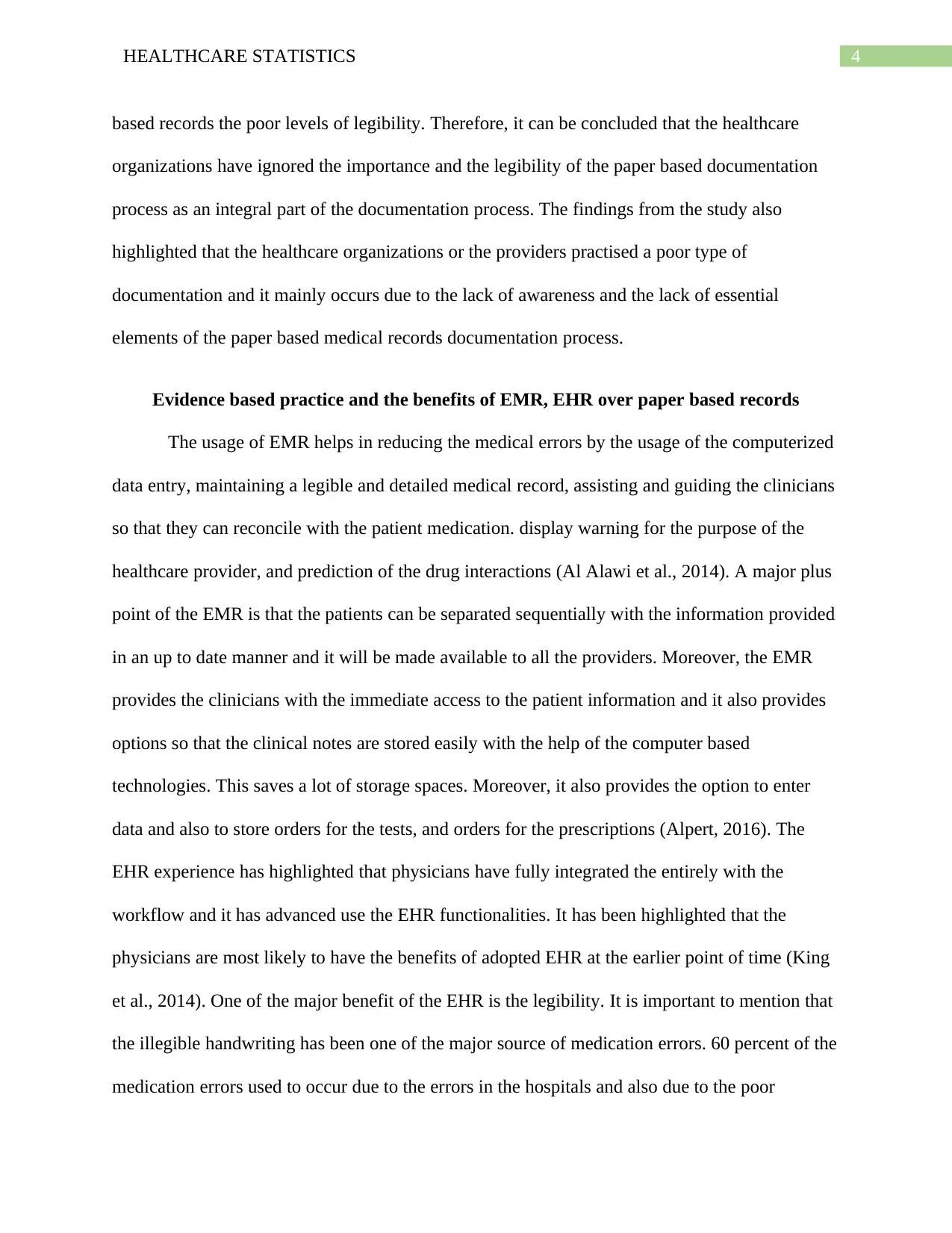
4HEALTHCARE STATISTICS
based records the poor levels of legibility. Therefore, it can be concluded that the healthcare
organizations have ignored the importance and the legibility of the paper based documentation
process as an integral part of the documentation process. The findings from the study also
highlighted that the healthcare organizations or the providers practised a poor type of
documentation and it mainly occurs due to the lack of awareness and the lack of essential
elements of the paper based medical records documentation process.
Evidence based practice and the benefits of EMR, EHR over paper based records
The usage of EMR helps in reducing the medical errors by the usage of the computerized
data entry, maintaining a legible and detailed medical record, assisting and guiding the clinicians
so that they can reconcile with the patient medication. display warning for the purpose of the
healthcare provider, and prediction of the drug interactions (Al Alawi et al., 2014). A major plus
point of the EMR is that the patients can be separated sequentially with the information provided
in an up to date manner and it will be made available to all the providers. Moreover, the EMR
provides the clinicians with the immediate access to the patient information and it also provides
options so that the clinical notes are stored easily with the help of the computer based
technologies. This saves a lot of storage spaces. Moreover, it also provides the option to enter
data and also to store orders for the tests, and orders for the prescriptions (Alpert, 2016). The
EHR experience has highlighted that physicians have fully integrated the entirely with the
workflow and it has advanced use the EHR functionalities. It has been highlighted that the
physicians are most likely to have the benefits of adopted EHR at the earlier point of time (King
et al., 2014). One of the major benefit of the EHR is the legibility. It is important to mention that
the illegible handwriting has been one of the major source of medication errors. 60 percent of the
medication errors used to occur due to the errors in the hospitals and also due to the poor
based records the poor levels of legibility. Therefore, it can be concluded that the healthcare
organizations have ignored the importance and the legibility of the paper based documentation
process as an integral part of the documentation process. The findings from the study also
highlighted that the healthcare organizations or the providers practised a poor type of
documentation and it mainly occurs due to the lack of awareness and the lack of essential
elements of the paper based medical records documentation process.
Evidence based practice and the benefits of EMR, EHR over paper based records
The usage of EMR helps in reducing the medical errors by the usage of the computerized
data entry, maintaining a legible and detailed medical record, assisting and guiding the clinicians
so that they can reconcile with the patient medication. display warning for the purpose of the
healthcare provider, and prediction of the drug interactions (Al Alawi et al., 2014). A major plus
point of the EMR is that the patients can be separated sequentially with the information provided
in an up to date manner and it will be made available to all the providers. Moreover, the EMR
provides the clinicians with the immediate access to the patient information and it also provides
options so that the clinical notes are stored easily with the help of the computer based
technologies. This saves a lot of storage spaces. Moreover, it also provides the option to enter
data and also to store orders for the tests, and orders for the prescriptions (Alpert, 2016). The
EHR experience has highlighted that physicians have fully integrated the entirely with the
workflow and it has advanced use the EHR functionalities. It has been highlighted that the
physicians are most likely to have the benefits of adopted EHR at the earlier point of time (King
et al., 2014). One of the major benefit of the EHR is the legibility. It is important to mention that
the illegible handwriting has been one of the major source of medication errors. 60 percent of the
medication errors used to occur due to the errors in the hospitals and also due to the poor
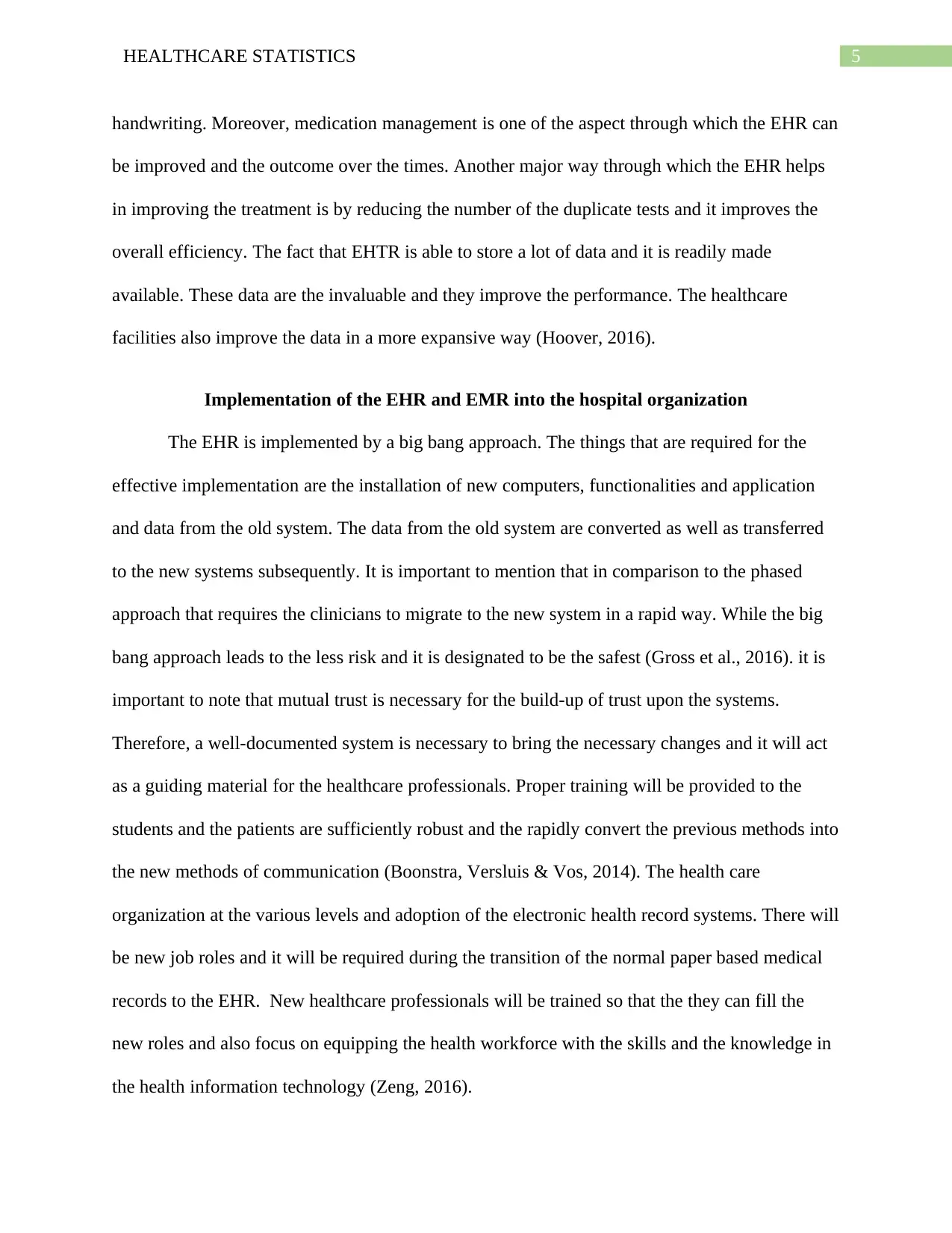
5HEALTHCARE STATISTICS
handwriting. Moreover, medication management is one of the aspect through which the EHR can
be improved and the outcome over the times. Another major way through which the EHR helps
in improving the treatment is by reducing the number of the duplicate tests and it improves the
overall efficiency. The fact that EHTR is able to store a lot of data and it is readily made
available. These data are the invaluable and they improve the performance. The healthcare
facilities also improve the data in a more expansive way (Hoover, 2016).
Implementation of the EHR and EMR into the hospital organization
The EHR is implemented by a big bang approach. The things that are required for the
effective implementation are the installation of new computers, functionalities and application
and data from the old system. The data from the old system are converted as well as transferred
to the new systems subsequently. It is important to mention that in comparison to the phased
approach that requires the clinicians to migrate to the new system in a rapid way. While the big
bang approach leads to the less risk and it is designated to be the safest (Gross et al., 2016). it is
important to note that mutual trust is necessary for the build-up of trust upon the systems.
Therefore, a well-documented system is necessary to bring the necessary changes and it will act
as a guiding material for the healthcare professionals. Proper training will be provided to the
students and the patients are sufficiently robust and the rapidly convert the previous methods into
the new methods of communication (Boonstra, Versluis & Vos, 2014). The health care
organization at the various levels and adoption of the electronic health record systems. There will
be new job roles and it will be required during the transition of the normal paper based medical
records to the EHR. New healthcare professionals will be trained so that the they can fill the
new roles and also focus on equipping the health workforce with the skills and the knowledge in
the health information technology (Zeng, 2016).
handwriting. Moreover, medication management is one of the aspect through which the EHR can
be improved and the outcome over the times. Another major way through which the EHR helps
in improving the treatment is by reducing the number of the duplicate tests and it improves the
overall efficiency. The fact that EHTR is able to store a lot of data and it is readily made
available. These data are the invaluable and they improve the performance. The healthcare
facilities also improve the data in a more expansive way (Hoover, 2016).
Implementation of the EHR and EMR into the hospital organization
The EHR is implemented by a big bang approach. The things that are required for the
effective implementation are the installation of new computers, functionalities and application
and data from the old system. The data from the old system are converted as well as transferred
to the new systems subsequently. It is important to mention that in comparison to the phased
approach that requires the clinicians to migrate to the new system in a rapid way. While the big
bang approach leads to the less risk and it is designated to be the safest (Gross et al., 2016). it is
important to note that mutual trust is necessary for the build-up of trust upon the systems.
Therefore, a well-documented system is necessary to bring the necessary changes and it will act
as a guiding material for the healthcare professionals. Proper training will be provided to the
students and the patients are sufficiently robust and the rapidly convert the previous methods into
the new methods of communication (Boonstra, Versluis & Vos, 2014). The health care
organization at the various levels and adoption of the electronic health record systems. There will
be new job roles and it will be required during the transition of the normal paper based medical
records to the EHR. New healthcare professionals will be trained so that the they can fill the
new roles and also focus on equipping the health workforce with the skills and the knowledge in
the health information technology (Zeng, 2016).
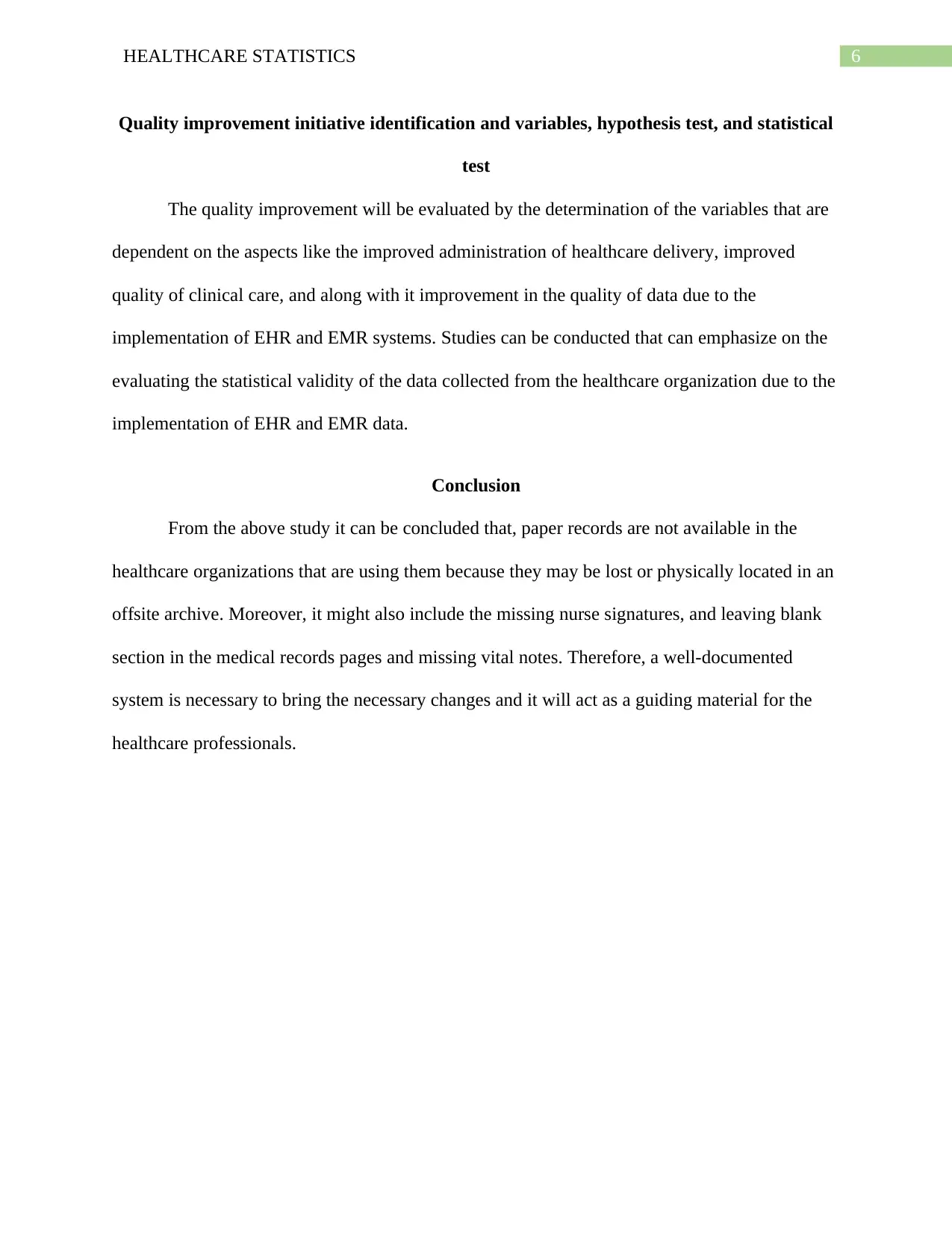
6HEALTHCARE STATISTICS
Quality improvement initiative identification and variables, hypothesis test, and statistical
test
The quality improvement will be evaluated by the determination of the variables that are
dependent on the aspects like the improved administration of healthcare delivery, improved
quality of clinical care, and along with it improvement in the quality of data due to the
implementation of EHR and EMR systems. Studies can be conducted that can emphasize on the
evaluating the statistical validity of the data collected from the healthcare organization due to the
implementation of EHR and EMR data.
Conclusion
From the above study it can be concluded that, paper records are not available in the
healthcare organizations that are using them because they may be lost or physically located in an
offsite archive. Moreover, it might also include the missing nurse signatures, and leaving blank
section in the medical records pages and missing vital notes. Therefore, a well-documented
system is necessary to bring the necessary changes and it will act as a guiding material for the
healthcare professionals.
Quality improvement initiative identification and variables, hypothesis test, and statistical
test
The quality improvement will be evaluated by the determination of the variables that are
dependent on the aspects like the improved administration of healthcare delivery, improved
quality of clinical care, and along with it improvement in the quality of data due to the
implementation of EHR and EMR systems. Studies can be conducted that can emphasize on the
evaluating the statistical validity of the data collected from the healthcare organization due to the
implementation of EHR and EMR data.
Conclusion
From the above study it can be concluded that, paper records are not available in the
healthcare organizations that are using them because they may be lost or physically located in an
offsite archive. Moreover, it might also include the missing nurse signatures, and leaving blank
section in the medical records pages and missing vital notes. Therefore, a well-documented
system is necessary to bring the necessary changes and it will act as a guiding material for the
healthcare professionals.
Paraphrase This Document
Need a fresh take? Get an instant paraphrase of this document with our AI Paraphraser
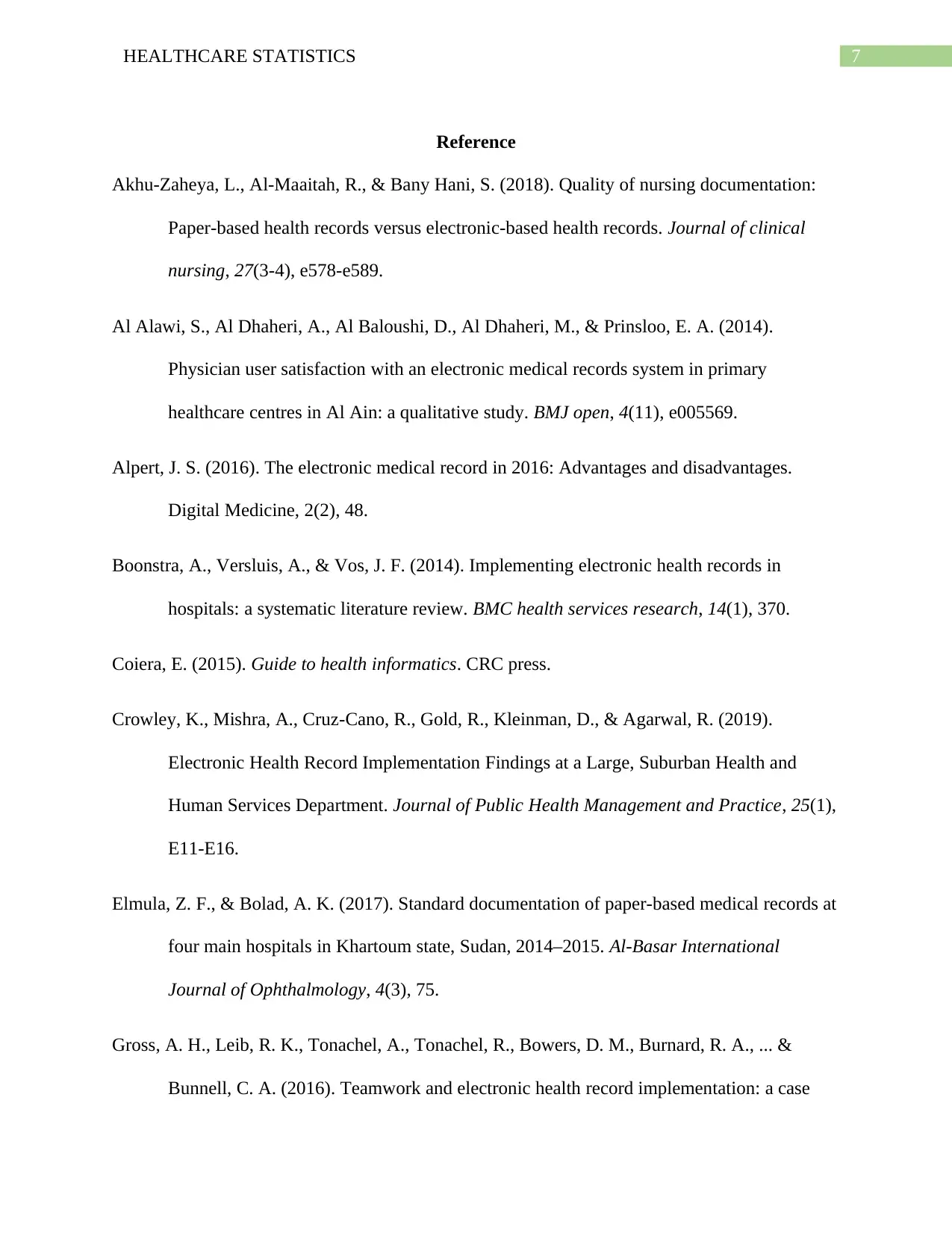
7HEALTHCARE STATISTICS
Reference
Akhu‐Zaheya, L., Al‐Maaitah, R., & Bany Hani, S. (2018). Quality of nursing documentation:
Paper‐based health records versus electronic‐based health records. Journal of clinical
nursing, 27(3-4), e578-e589.
Al Alawi, S., Al Dhaheri, A., Al Baloushi, D., Al Dhaheri, M., & Prinsloo, E. A. (2014).
Physician user satisfaction with an electronic medical records system in primary
healthcare centres in Al Ain: a qualitative study. BMJ open, 4(11), e005569.
Alpert, J. S. (2016). The electronic medical record in 2016: Advantages and disadvantages.
Digital Medicine, 2(2), 48.
Boonstra, A., Versluis, A., & Vos, J. F. (2014). Implementing electronic health records in
hospitals: a systematic literature review. BMC health services research, 14(1), 370.
Coiera, E. (2015). Guide to health informatics. CRC press.
Crowley, K., Mishra, A., Cruz-Cano, R., Gold, R., Kleinman, D., & Agarwal, R. (2019).
Electronic Health Record Implementation Findings at a Large, Suburban Health and
Human Services Department. Journal of Public Health Management and Practice, 25(1),
E11-E16.
Elmula, Z. F., & Bolad, A. K. (2017). Standard documentation of paper-based medical records at
four main hospitals in Khartoum state, Sudan, 2014–2015. Al-Basar International
Journal of Ophthalmology, 4(3), 75.
Gross, A. H., Leib, R. K., Tonachel, A., Tonachel, R., Bowers, D. M., Burnard, R. A., ... &
Bunnell, C. A. (2016). Teamwork and electronic health record implementation: a case
Reference
Akhu‐Zaheya, L., Al‐Maaitah, R., & Bany Hani, S. (2018). Quality of nursing documentation:
Paper‐based health records versus electronic‐based health records. Journal of clinical
nursing, 27(3-4), e578-e589.
Al Alawi, S., Al Dhaheri, A., Al Baloushi, D., Al Dhaheri, M., & Prinsloo, E. A. (2014).
Physician user satisfaction with an electronic medical records system in primary
healthcare centres in Al Ain: a qualitative study. BMJ open, 4(11), e005569.
Alpert, J. S. (2016). The electronic medical record in 2016: Advantages and disadvantages.
Digital Medicine, 2(2), 48.
Boonstra, A., Versluis, A., & Vos, J. F. (2014). Implementing electronic health records in
hospitals: a systematic literature review. BMC health services research, 14(1), 370.
Coiera, E. (2015). Guide to health informatics. CRC press.
Crowley, K., Mishra, A., Cruz-Cano, R., Gold, R., Kleinman, D., & Agarwal, R. (2019).
Electronic Health Record Implementation Findings at a Large, Suburban Health and
Human Services Department. Journal of Public Health Management and Practice, 25(1),
E11-E16.
Elmula, Z. F., & Bolad, A. K. (2017). Standard documentation of paper-based medical records at
four main hospitals in Khartoum state, Sudan, 2014–2015. Al-Basar International
Journal of Ophthalmology, 4(3), 75.
Gross, A. H., Leib, R. K., Tonachel, A., Tonachel, R., Bowers, D. M., Burnard, R. A., ... &
Bunnell, C. A. (2016). Teamwork and electronic health record implementation: a case
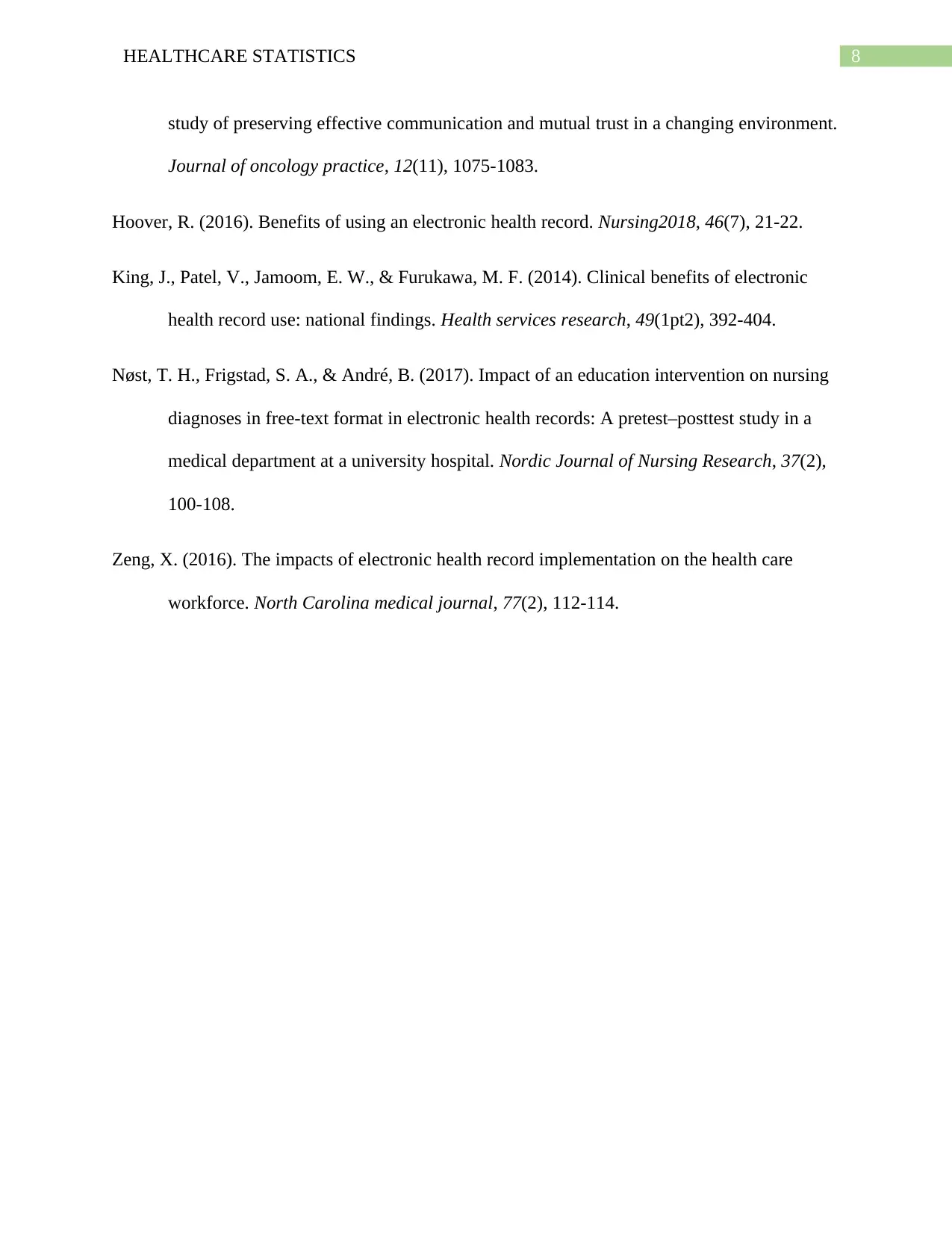
8HEALTHCARE STATISTICS
study of preserving effective communication and mutual trust in a changing environment.
Journal of oncology practice, 12(11), 1075-1083.
Hoover, R. (2016). Benefits of using an electronic health record. Nursing2018, 46(7), 21-22.
King, J., Patel, V., Jamoom, E. W., & Furukawa, M. F. (2014). Clinical benefits of electronic
health record use: national findings. Health services research, 49(1pt2), 392-404.
Nøst, T. H., Frigstad, S. A., & André, B. (2017). Impact of an education intervention on nursing
diagnoses in free-text format in electronic health records: A pretest–posttest study in a
medical department at a university hospital. Nordic Journal of Nursing Research, 37(2),
100-108.
Zeng, X. (2016). The impacts of electronic health record implementation on the health care
workforce. North Carolina medical journal, 77(2), 112-114.
study of preserving effective communication and mutual trust in a changing environment.
Journal of oncology practice, 12(11), 1075-1083.
Hoover, R. (2016). Benefits of using an electronic health record. Nursing2018, 46(7), 21-22.
King, J., Patel, V., Jamoom, E. W., & Furukawa, M. F. (2014). Clinical benefits of electronic
health record use: national findings. Health services research, 49(1pt2), 392-404.
Nøst, T. H., Frigstad, S. A., & André, B. (2017). Impact of an education intervention on nursing
diagnoses in free-text format in electronic health records: A pretest–posttest study in a
medical department at a university hospital. Nordic Journal of Nursing Research, 37(2),
100-108.
Zeng, X. (2016). The impacts of electronic health record implementation on the health care
workforce. North Carolina medical journal, 77(2), 112-114.
1 out of 9
Related Documents
Your All-in-One AI-Powered Toolkit for Academic Success.
+13062052269
info@desklib.com
Available 24*7 on WhatsApp / Email
![[object Object]](/_next/static/media/star-bottom.7253800d.svg)
Unlock your academic potential
© 2024 | Zucol Services PVT LTD | All rights reserved.




